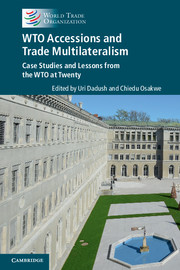Book contents
- Frontmatter
- Dedication
- Contents
- List of contributors
- Foreword
- Acknowledgements
- List of abbreviations
- Editors' note
- PART I WTO accessions, the trading system and the global economy
- PART II Overview: systemic outcomes from accessions
- PART III Members’ perspectives on accession negotiations
- PART IV Working party chairpersons’ perspectives on accession negotiations
- 25 Facilitating accessions: the role of the working party chairperson
- 26 A podium perspective: experiences and challenges of chairing a working party
- 27 Are there different rules for least-developed countries in a rule-based system?
- 28 Managing the challenge of acceding post-conflict states
- PART V Salient features inWTOAccession Protocols
- PART VI Conclusion
- Annex: Contributor biographies
- Index
- Plate section
25 - Facilitating accessions: the role of the working party chairperson
from PART IV - Working party chairpersons’ perspectives on accession negotiations
Published online by Cambridge University Press: 05 November 2015
- Frontmatter
- Dedication
- Contents
- List of contributors
- Foreword
- Acknowledgements
- List of abbreviations
- Editors' note
- PART I WTO accessions, the trading system and the global economy
- PART II Overview: systemic outcomes from accessions
- PART III Members’ perspectives on accession negotiations
- PART IV Working party chairpersons’ perspectives on accession negotiations
- 25 Facilitating accessions: the role of the working party chairperson
- 26 A podium perspective: experiences and challenges of chairing a working party
- 27 Are there different rules for least-developed countries in a rule-based system?
- 28 Managing the challenge of acceding post-conflict states
- PART V Salient features inWTOAccession Protocols
- PART VI Conclusion
- Annex: Contributor biographies
- Index
- Plate section
Summary
ABSTRACT
What is the role of the chairperson of a working party? What instruments can he or she use to manage the complexities of the WTO accession process? Typically, WTO accession negotiations are time consuming because of extensive domestic legislative and institutional reforms, which need to be aligned with economic development strategies. These reforms focus on the tough questions of eliminating trade barriers, improving governance, tackling corruption and enforcing the rule of law through WTO-consistent legislation. Formally, the function of the chairperson is to preside over working party meetings. In practice, the chairperson works as part of a team with the WTO Secretariat, led by the Accessions Division, in seeking to identify the balance of interests and what the market can bear, and hence leading the working party to develop a common view of its purpose and shared responsibility.
The successful conclusion of WTO accession negotiations should not be taken for granted. These negotiations typically involve extensive and often time-consuming domestic legislative and institutional reforms, which need to be aligned to economic development strategies. The reforms include improving governance, tackling corruption and enforcing the rule of law. The resulting Accession Packages, therefore, represent a delicate balance that has been meticulously crafted over many years on the basis of careful analysis, hard negotiation and detailed technical work.
The chairperson works as part of a team with the WTO Secretariat Accessions Division team led by the Director of the Accessions Division, the Secretary of the working party and relevant WTO Secretariat divisions.
Formally, the function of the chairperson is to preside over the working party meetings. In reality, there is much more. The chairperson, for instance, can be instrumental in mediating between the WTO Secretariat, member states and acceding government authorities, testing the political willingness to move forward, passing messages and facilitating the clarification of positions. The chairperson's aim should be to identify and balance the interests, release the potential energies of all parties and lead the working party to develop a common view of its purposes and shared responsibility. The chairperson should play the role of a stimulator. A good understanding of the psychology of negotiations and the ability to build confidence and trust between all parties are necessary prerequisites for the work of the chairperson.
- Type
- Chapter
- Information
- WTO Accessions and Trade MultilateralismCase Studies and Lessons from the WTO at Twenty, pp. 581 - 591Publisher: Cambridge University PressPrint publication year: 2015



